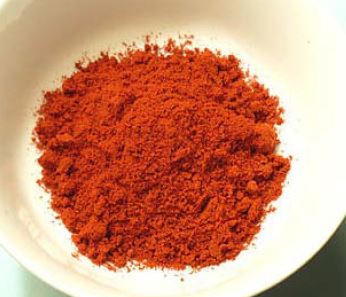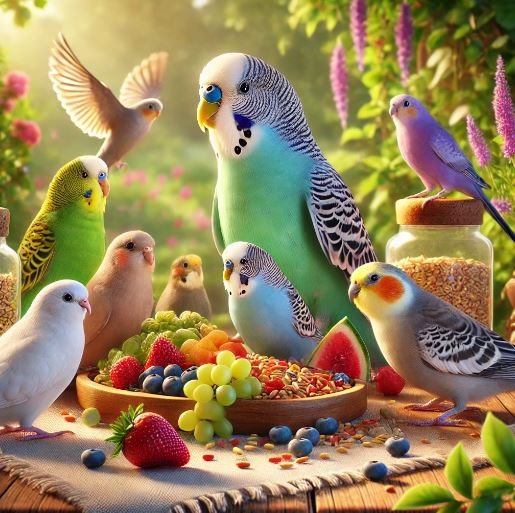Can Birds Eat Paprika? Parrots, Budgies, Cockatiels, Finches, Pigeons
Can Birds Eat paprika? Yes, birds can safely eat paprika, including parrots, budgies, cockatiels, finches, and pigeons. Paprika, made from dried and ground bell peppers or chili peppers, contains beneficial nutrients without the spiciness that affects mammals. Here’s how paprika can be beneficial and how to offer it to your birds:

Benefits of Paprika
- Rich in Nutrients: Paprika is a good source of vitamins A, E, and B6, as well as antioxidants, which can support your bird’s immune system and overall health.
- Color Enhancement: The carotenoids in paprika can enhance the vibrant colors of feathers, especially in birds with red, orange, or yellow plumage.
- Safe for All Birds: Birds lack the receptors that make capsaicin (the compound that gives peppers their heat) spicy for mammals, so they can enjoy paprika without discomfort.
Feeding Guidelines
- Form: Offer paprika in powdered form by sprinkling it over your bird’s food. You can also mix it with their regular seed or pellet diet.
- Moderation: While paprika is safe, it should be used in moderation as part of a balanced diet. Too much of any supplement can upset the dietary balance.
- Freshness: Ensure the paprika is fresh and free from additives, salt, or preservatives, which could be harmful to birds.
Can Birds Eat paprika? Birds That Can Enjoy Paprika
- Parrots: African Greys, Amazons, Cockatoos, and other parrots can benefit from the added nutrients in paprika.
- Budgies (Parakeets): Budgies can enjoy paprika sprinkled on their seed or pellet mix for an added nutritional boost.
- Cockatiels: Paprika can be a healthy addition to a cockatiel’s diet, helping to maintain vibrant feather colors.
- Finches: Small birds like finches can benefit from a tiny pinch of paprika mixed with their food.
- Pigeons: Pigeons can also safely consume paprika as part of their diet.
Can Birds Eat paprika? Conclusion
Paprika can be a healthy and beneficial addition to your birds’ diet, providing essential vitamins and antioxidants. It’s suitable for a wide range of bird species, including parrots, budgies, cockatiels, finches, and pigeons. Just be sure to use it in moderation and ensure it’s pure, without any added ingredients. As always, observe your birds for any signs of adverse reactions when introducing new foods, and consult an avian veterinarian if you have any concerns.

Here’s a simple and nutritious recipe that incorporates paprika, suitable for parrots, budgies, cockatiels, finches, and pigeons. This recipe provides a variety of nutrients while adding the health benefits of paprika.
Can Birds Eat paprika? Paprika Birdie Mash Recipe
Ingredients:
- 1/2 cup cooked quinoa (or millet)
- 1/2 cup mixed vegetables (carrots, peas, corn, sweet potato, chopped finely or mashed)
- 1/4 cup cooked beans (kidney beans, chickpeas, or lentils, thoroughly cooked and mashed)
- 1/4 cup chopped leafy greens (like spinach, kale, or parsley)
- 1 tablespoon ground flaxseed (optional for extra omega-3 fatty acids)
- 1 teaspoon paprika (ensure it’s pure, without any added salt or preservatives)
- 1/4 teaspoon turmeric (optional for additional anti-inflammatory benefits)
- 1 teaspoon crushed eggshells or cuttlebone powder (for added calcium, optional)
Instructions:
- Cook the Quinoa:
- Rinse the quinoa thoroughly under cold water to remove any bitterness.
- Cook the quinoa according to package instructions. Typically, this involves boiling it in water until the grains are tender and fluffy. Let it cool to room temperature.
- Prepare the Vegetables:
- Steam or lightly cook the mixed vegetables until they are soft enough to mash or chop finely. Allow them to cool.
- Cook and Mash the Beans:
- Thoroughly cook the beans until they are soft. Mash them with a fork to make them easier for the birds to eat.
- Combine Ingredients:
- In a large bowl, mix the cooked quinoa, mashed vegetables, mashed beans, and chopped leafy greens.
- Add the ground flaxseed, paprika, turmeric, and crushed eggshells (if using) to the mixture.
- Mix Thoroughly:
- Stir all the ingredients together until well combined. Ensure that the paprika is evenly distributed throughout the mixture.
- Serve:
- Offer a small portion of the paprika birdie mash to your birds. You can place it in their food dish or offer it as a treat.
- Storage:
- Store any leftovers in an airtight container in the refrigerator. The mash can be stored for up to 3 days. For longer storage, portion out the mash into small servings and freeze it. Thaw before serving.
Feeding Tips:
- Portion Size: Adjust the portion size based on the size and dietary needs of your birds. Smaller birds like finches will require much less than larger parrots.
- Introduce Gradually: If your birds are not used to new foods, introduce the mash gradually, mixing it with their regular diet until they become accustomed to it.
- Observe: Keep an eye on your birds to ensure they are enjoying the mash and that it agrees with their digestive systems.
Nutritional Benefits:
- Quinoa provides protein and essential amino acids.
- Vegetables offer vitamins, minerals, and fiber.
- Beans are a good source of protein and iron.
- Leafy Greens supply additional vitamins, especially vitamin K and A.
- Paprika adds vitamin A, antioxidants, and color enhancement.
- Turmeric offers anti-inflammatory benefits.
- Flaxseed adds omega-3 fatty acids for healthy skin and feathers.
- Eggshells/Cuttlebone Powder provide calcium, important for bone health.
This recipe is versatile, so feel free to adjust the ingredients based on your birds’ preferences and nutritional needs!
Can Birds Eat paprika? Info-table
| Name: |
| Paprika |
| Scientific name: |
| Also known as: |
| Indigenous Countries: |
| Originating in central Mexico, paprika was brought to Spain in the 16th century. |
| Description: |
| A ground spice made from dried red fruits of the larger and sweeter varieties of the plant called bell pepper or sweet pepper. |
| Nutritional Value: |
| Rich in vitamin A, moderate in vitamin B6 and vitamin E. |
| Feeding: |
| Mix in food. |
| Discussion: |
| Use to attract birds to healthy foods. |


